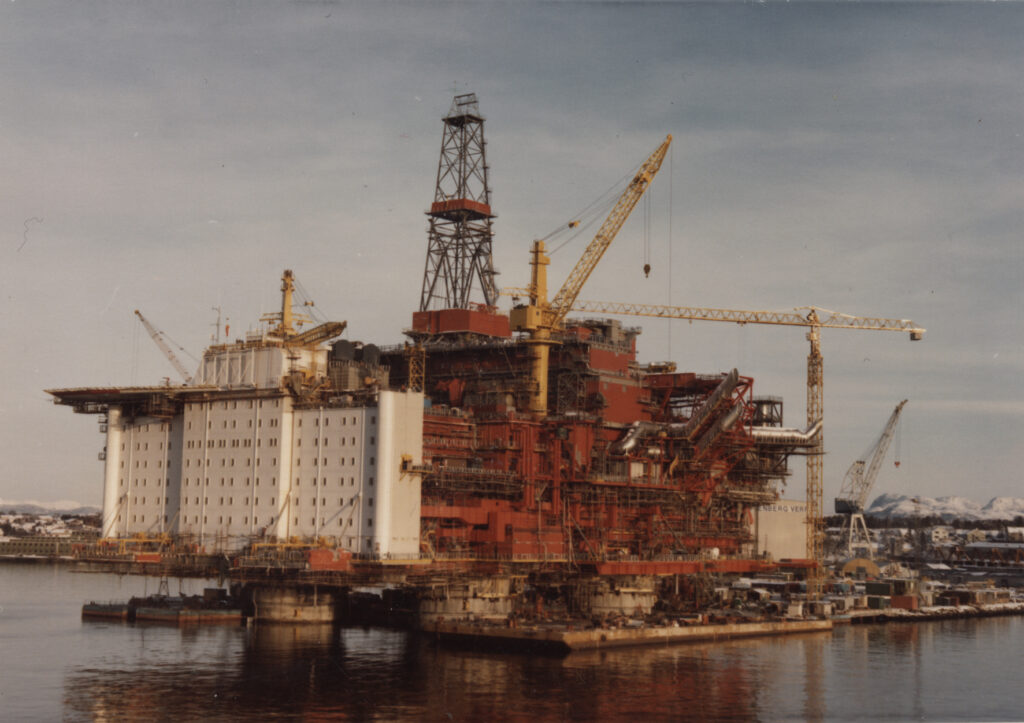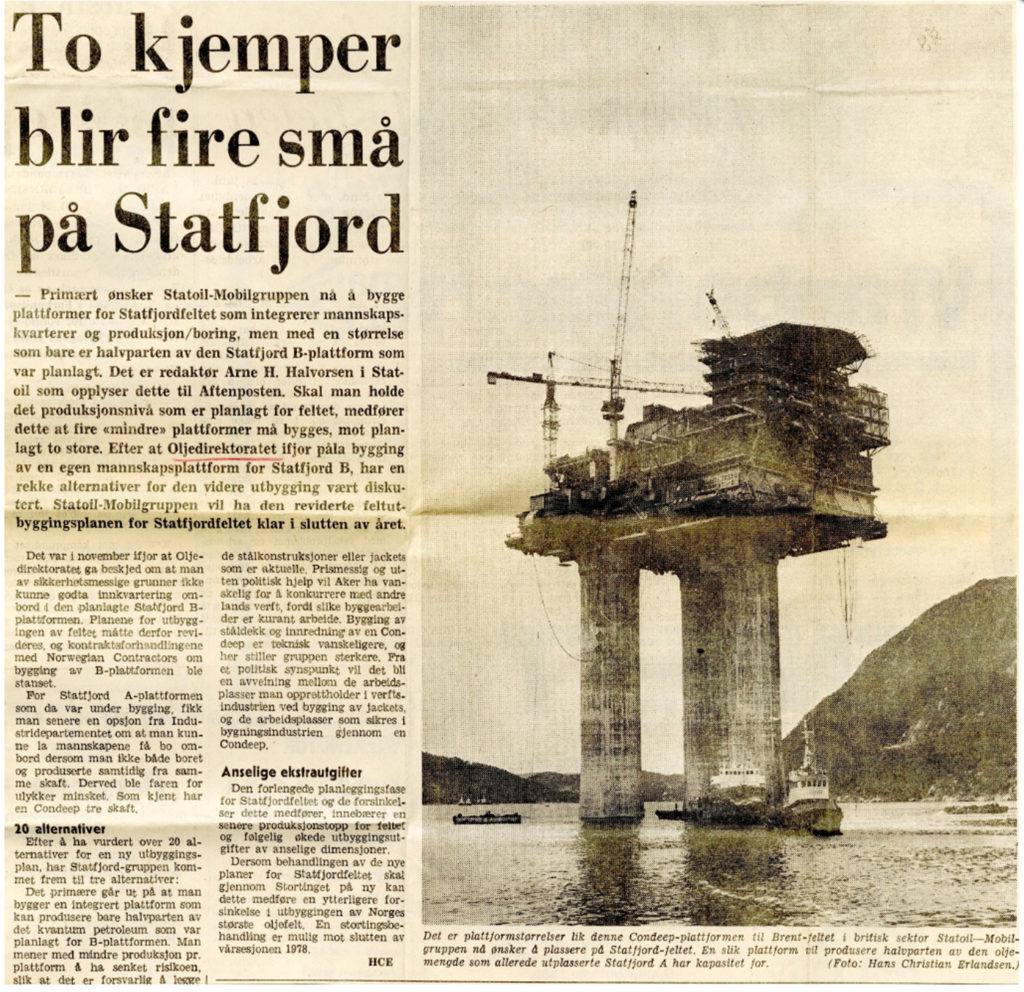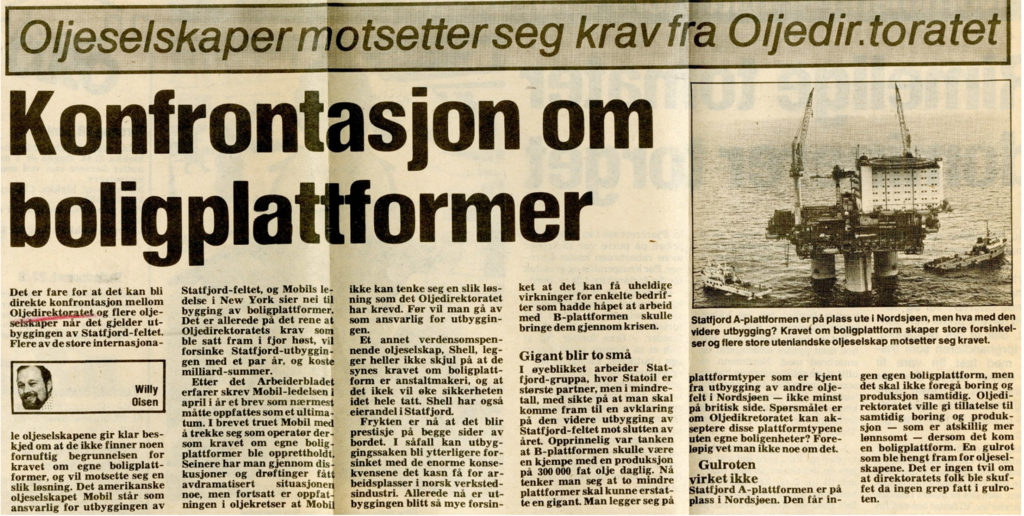Letter from the NPD

The recently formed Norwegian Petroleum Consultants joint venture had already signed a contract for project management and engineering of the B structure. While fabrication of the deck and outfitting of the concrete shafts remained to be finalised, an option agreement had been reached with the Aker group.
As things stood, the major contracts thereby appeared to be in place. After the Storting had approved phase II of the development plan in June 1976, most people assumed it was just a matter of starting work. However, the NPD – which was responsible at the time for safety offshore – also wanted to say its piece. It did that in a letter sent to Statoil and operator Mobil on 11 November 1976, which altered all the plans.
Vogt committee

New safety regulations for the offshore industry had been introduced earlier that year. Where Statfjord B and the licensees were concerned, a key point in these was a more restrictive attitude to placing drilling, production and living quarters on a single integrated platform. The rules had been drawn up by the Vogt committee, originally appointed by the government as far back as 22 March 1970 with a mandate to deliver draft safety regulations. They would apply to production and storage facilities on the seabed as well as the utilisation of petroleum deposits.[REMOVE]Fotnote: Norsk Oljerevy, no 2, 1976, “Kontroll med sikkerheten fordelt på ni instanser”.
Work on the provisions made slow progress and senior foreign ministry official Jens Evensen, who chaired the committee, eventually asked to be relieved. He was replaced by director general Lars Oftedal Broch from the Ministry of Justice in November 1972, and then by Nils Vogt from the NPD in May 1974. The committee presented its recommendations to the Ministry of Industry on 12 June 1975, after which a consultation process was held with affected parties, institutions and companies.[REMOVE]Fotnote: Hanisch, T, Nerheim, G and the Norwegian Petroleum Society, 1992, Fra vantro til overmot?, Norsk Oljehistorie, vol 1, Leseselskapet, Oslo: 324.
Adopted by royal decree of 9 July 1976, the safety regulations were based on the Vogt committee’s proposals and the comments received. A presumption in the decree was that the NPD would have the main responsibility for regulating fixed offshore installations. So the directorate reviewed the safety aspects of the Statfjord B facility on the basis of the new regulations. It kept the industry ministry informed about its work, including the following comment in a letter dated 7 July 1976:
On the basis of the ongoing work with safety-related conditions, it has been found necessary to adopt a more restrictive attitude towards the concepts which are based on combined production and drilling and where the living quarters are placed on the same platform. The main intention of the Vogt committee’s recommendations runs counter to both combined activity and the placing of living quarters as mentioned. […]. The NPD would emphasise that combined drilling and production will only be accepted after individual analyses and assessments. That also applies to living quarters which it is proposed to place on a drilling/production platform. Where Statfjord B is concerned, no final choice of concept has been made and no specific safety analysis is therefore available. The NPD will therefore have to wait until the factual conditions have been presented before commenting.[REMOVE]Fotnote: Norsk Oljerevy.
In other words, the ministry had been informed about the NPD’s work and its doubts about the plans for Statfjord B. As the letter noted, the NPD could not adopt a final view until the Statoil group had chosen its concept. It was not until the Statfjord unit owners’ committee (SUOC), the highest decision-making body for the licence, approved a final concept for the B platform in August 1976 that the NPD could present its own safety analysis.
The outcome of this assessment was communicated to the Statfjord group by letter on 11 November 1976. After questioning the safety of an integrated platform, the NPD ordered the construction of a separate quarters platform tied back to the B installation. It wrote:
The NPD is currently assessing the concept for Statfjord B, based on a general assessment of the safety regulations on the field in the light of new regulations (royal decree of 9 July 1976).
According to the directorate, the following assumptions were made for Statfjord B:
- a particularly complex and extensive production plant concentrated on one platform
- a large number of high-capacity producing wells as well as water and gas injection
- permanent living quarters for 200 people, which will be used by 400 personnel during construction and possibly drilling
- possible parallel drilling and production.
The NPD observed that the total risk was obtained from the contribution of each activity and process, with those listed above specified as examples. It assessed the overall risk related to these conditions as too high.
Fewer personnel
The letter went on to state that the best way to cut the overall risk would be to reduce the number of people present on the platform at any given time. “The NPD has accordingly concluded that a separate living quarters platform tied to Statfjord B should be built.”
This assessment was not confined to the B facility. It also posed questions about Statfjord A, which was at that time far advanced in the construction process and due to be towed out to the field within six months. The letter observed:
The considerations mentioned above also apply to Statfjord A, but somewhat less strongly. On the basis of the provisions in the royal decree of 9 July 1976, the NPD would therefore request that the company conducts a new overall assessment of safety conditions in relation to the planned drilling and production programme, where special attention is devoted to the quarters issue.
The letter was signed by Gunnar Hellesen, chair of the NPD, and Fredrik Hagemann, its director general.
New concept proposed
Statfjord B had been planned as a virtual copy of the A platform, but with four concrete support shafts rather than three. The processing facilities would be equally large and complex, providing a production capacity of 300 000 barrels of oil per day (bopd). A quarters module with 200 berths would also be placed on the platform – and it was this proposal in particular that the NPD wanted to halt, on the grounds that reducing the number of people on board at any time would cut the total risk. As the letter indicated (above), it was desirable to build separate platforms for production/drilling and quarters. The NPD also emphasised that this was the conclusion of an overall safety approach, and wanted a separate safety study before detail engineering began.
Statoil and Mobil expressed astonishment at the letter, and claimed to have not heard that such assessments were being made. Arve Johnsen, then CEO of the Norwegian company, described his reaction to the NPD letter in a later memoir: “I received many different kinds of letter as CEO of Statoil. […] I forgot most of them. But I’ll remember one of them to my dying day […] It sent a shockwave through the licensees in the Statfjord group”.[REMOVE]Fotnote: Johnsen, A, 1988, Utfordringen: Statoil-år, Gyldendal, Oslo: 202.
That the licensees had not seen the possibility of this occurring may seem incomprehensible. It had long been clear that the NPD was looking at the problems associated with parallel drilling and production. The Vogt committee’s recommendations had been the subject of a consultation, and the comments made then – along with the report itself – formed the basis for the new safety regulations. Adopted in June, four months before the letter was sent, these made it clear that drilling and production should not be conducted in parallel without special consent. This should have sent signals that it could be more difficult to win acceptance for the Statfjord B plans than Statoil/Mobil assumed. As late as 12 October, NPD section manager Harald Ynnesdal had explained the directorate’s views on the matter in a speech he gave in Kristiansand:
The new platform type is particularly complex and difficult to assess from a safety perspective where these combined activities are concerned. Production fields should be planned as far as possible with separate quarters platforms. The production platforms, with the combined activities, could then be assessed as pure industrial facilities.
When assessing the Statfjord project, for example, with regard to parallel drilling and production, the problem would have been much simpler if separate quarters platforms had been provided. Where this project is concerned, the cost of such facilities would have had a small effect on profitability but would have meant a lot for overall safety and the desire for an early start to production.[REMOVE]Fotnote: Norsk Oljerevy, no 9, 1976, “Statfjord – planer og virkelighet”.

Following the letter, an extraordinary meeting of the SUOC was convened on 26 November. This decided that all activities related to the Statfjord B project should be halted. It would have to be re-evaluated and extensive concept studies carried out with every option from one to three platforms.
The Statfjord field engineering committee (SFEC) responsible for technical aspects of the development met in January 1977. A sub-committee of 35 members was appointed to study and assess various concepts for the B platform, and came up with no less than 39 solutions for review.
A new meeting took place in the SUOC on 18 March, where Statoil expressed concern over progress. The project had a tight schedule, and order books at the yards scheduled to do the construction work were empty. To speed up the process, the company proposed building a separate drilling installation linked by bridge to a combined production/quarters platform. A drilling facility on a steel jacket, for example, would be relatively simple to build and could be ready for tow-out as early as 1979. That would allow production drilling to start as soon as the platform had been installed and continue while the production/quarters unit was built. Oil and gas could thereby start to flow as soon as the latter was in position.[REMOVE]Fotnote: Norsk Oljerevy, no 5, 1977, “Industrien må fortsatt vente på ‘Statfjord B’.”
It would thereby be possible to meet the original timetable outlined in the field development plan. Mobil and Norway’s Saga Petroleum were strongly opposed to this proposal, but lacked the votes to stop it. They only had 25 per cent between them, and a proposal in the SUOC needed 70 per cent support to succeed. So the scheme was approved – against the operator’s vote.
Esso also submitted a proposal to the meeting, which retained a combined drilling, production and quarters facility but halved its production capacity from 300 000 bopd to 150 000. This installation would be simpler, since it needed only one process train compared with two, and overall safety would improve. Mobil supported this plan. It was adamantly opposed to the two-platform solution and maintained that no safety benefit would be gained. Poor seabed conditions on Statfjord played their part in the assessment. The question was whether positioning two platforms so close to each other and connecting them with a bridge carrying pipelines under high pressure would pose a safety risk.
The thought of the big capital cost of two platforms also worried the operator. On the other hand, experience from other projects in the North Sea indicated that 150 000 bopd would be sufficient. Such a solution would reduce construction costs, since the platform was simplified, and production could also begin earlier.
Threats
The SUOC met again on 28 April. Mobil presented a proposal for an integrated platform with one process train and an average capacity of 180 000 bopd. By choosing that size, it hoped to avoid the need for a separate accommodation structure. However, this was such a big change from the original concept that a completely new field development plan might be needed. The one approved by the Storting (parliament) in the summer of 1976 assumed three platforms with a combined daily capacity of 900 000 bopd. Smaller installations would either require more of these or a lower production tempo.[REMOVE]Fotnote: Ibid.
A new round in the Storting could delay the project even further. At the same time, Mobil vetoed a separate quarters platform with strong support from Esso.[REMOVE]Fotnote: Moe, J, 1980), Kostnadsanalysen norsk kontinentalsokkel: Rapport fra styringsgruppen oppnevnt ved kongelig resolusjon av 16. mars 1979: Rapporten avgitt til Olje- og energidepartementet 29. april 1980 : 2 : Utbyggingsprosjektene på norsk sokkel (vol 2), Ministry of Petroleum and Energy, Oslo. The operator could not accept a solution which met the NPD’s requirement that drilling and production should not in principle be conducted in parallel on the same platform. Clear instructions had been received from the US company’s head office in New York that any compromise which involved acceptance of the NPD’s attitude was out of the question. If it yielded to this demand, Mobil feared that similar requirements could be imposed on other continental shelves. That would have major consequences both for it and for other oil companies.

A telex from New York made it clear that it looked as if concrete platforms of Statfjord A’s size had had their day on that field, and Mobil was willing to resign as operator for the B platform if a two-platform solution was adopted. That took Statoil and the Norwegian government by surprise.[REMOVE]Fotnote: Norsk Oljerevy, no 5, 1977, op.cit.”
Statoil investigated the possibility of securing another operator, but none of the remaining partners were willing to undertake the role without a redistribution of interests. Mobil and Esso had put their prestige on the line, and finally succeeded in convincing the state company of the technical problems a two-platform solution would pose. The argument that it might influence later developments in deeper water was a key factor in changing Statoil’s view.
In parallel with the discussion on one or more platforms and the study of various concepts, new seismic data for the field cut its estimated reserves from 3.9 billion barrels of oil (527 million tonnes) to 3.2 billion (432 million). That reduced the need for two process trains on Statfjord B.
A clarification
On 5 August, the SUOC approved plans for a platform carrying a process train with a capacity of 180 000 bopd. It agreed on 29 November to apply to the NPD for permission to install such a facility. The application, accompanied by a safety study, was submitted on 1 December 1977.
The plan now called for the platform to be placed in 149 metres of water at the southern end of the field. Since seabed conditions there were poorer than on the rest of Statfjord, the base area of the concrete gravity base structure (GBS) had to be increased. While Statfjord A had 19 vertical cells, its companion would be built with 24. The topside area had to increase correspondingly, from 5 200 square metres to 7 800. This would still rest on four shafts, but only one process train would be installed. With the fourth shaft reserved for the risers, space was thereby released in the other three.
An additional safety barrier was provided by deciding that the decks and modules would be open in order to reduce the risk of an explosion and limit damage were one to nevertheless occur. Distribution of the various functions was designed to ensure that no hazardous operations were located close to or below the living quarters. The latter were also to be provided with an additional firewall. These plans were approved by the NPD on 19 December 1977. The project had thereby been delayed by a year, and large costs had been incurred through a series of concept studies and reports. Henrik Ager-Hanssen, then deputy CEO of Statoil, characterised the letter from the NPD as the most expensive in Norwegian history and claimed that each word of it had added NOK 25 million to the project budget.
Viewed from a different perspective, as former Statoil staffer Bjørn Vidar Lerøen did with hindsight, oil prices rose to historic levels in subsequent years. The letter thereby became one of Norway’s most profitable.[REMOVE]Fotnote: Lerøen, B, 2002, Drops of black gold: Statoil 1972-2002, Statoil, Stavanger: 149.
The effect of the letter was a new layout design for SFB, which became the leader for future platform decks on the Norwegian continental shelf. What the British had to do after Piper A, it was done on the Norwegian continental shelf at the end of the 1970s, – without any driving accident, but as a consequence of an “untimely” letter that the authorities lashed out at.
arrow_backStatoil’s first discovery – Tommeliten Alpha 1/9-1Quiet in the ranks on landarrow_forward